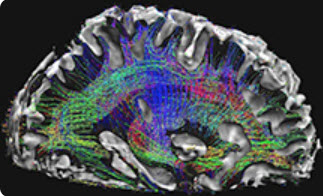Why is The BRAIN Initiative® needed?

With nearly 100 billion neurons and 100 trillion connections, the human brain remains one of the greatest mysteries in science and one of the greatest challenges in medicine. Neurological and psychiatric disorders, such as Alzheimer’s disease, Parkinson’s disease, autism, epilepsy, schizophrenia, depression, and traumatic brain injury, exact a tremendous toll on individuals, families, and society. Despite the many advances in neuroscience in recent years, the underlying causes of most of neurological and psychiatric conditions remain largely unknown, due to the vast complexity of the human brain. If we are ever to develop effective ways of helping people suffering from these devastating conditions, researchers will first need a more complete arsenal of tools and information for understanding how the brain functions both in health and disease.
Why is now the right time for The BRAIN Initiative®?

Source: NIH
In the last decade alone, scientists have made a number of landmark discoveries that now create the opportunity to unlock the mysteries of the brain. We have witnessed the sequencing of the human genome, the development of new tools for mapping neuronal connections, the increasing resolution of imaging technologies, and the explosion of nanoscience. These discoveries have yielded unprecedented opportunities for integration across scientific fields. For instance, by combining advanced genetic and optical techniques, scientists can now use pulses of light in animal models to determine how specific cell activities within the brain affect behavior. What’s more, through the integration of neuroscience and physics, researchers can now use high-resolution imaging technologies to observe how the brain is structurally and functionally connected in living humans.
How Will The BRAIN Initiative® work at NIH?

Given the ambitious scope of this pioneering endeavor, it was vital that planning be informed by a wide range of expertise and experience. Therefore, NIH established a high level working group of the Advisory Committee to the NIH Director (ACD) to help shape this new initiative. This working group, co-chaired by Dr. Cornelia “Cori” Bargmann (The Rockefeller University) and Dr. William Newsome (Stanford University) sought broad input from the scientific community, patient advocates, and the general public. Their report, BRAIN 2025: A Scientific Vision, released in June 2014 and enthusiastically endorsed by the ACD, articulated the scientific goals of The BRAIN Initiative® and developed a multi-year scientific plan for achieving these goals, including timetables, milestones, and cost estimates.
Of course, a goal this audacious will require ideas from the best scientists and engineers across many diverse disciplines and sectors. Therefore, NIH is working in close collaboration with other government agencies, including the Defense Advanced Research Projects Agency (DARPA), National Science Foundation (NSF), the U.S. Food and Drug Administration (FDA) and Intelligence Advanced Research Projects Activity (IARPA). Private partners are also committed to ensuring success through investment in The BRAIN Initiative®.
Five years ago a project such as this would have been considered impossible. Five years from now will be too late. While the goals are profoundly ambitious, the time is right to inspire a new generation of neuroscientists to undertake the most groundbreaking approach ever contemplated to understanding how the brain works, and how disease occurs.
View and/or download a snapshot of the Initiative’s progress.
How will The BRAIN Initiative® be supported by NIH?

Through 2019, NIH has made over 700 awards to hundreds of investigators, totaling ~$1.3 billion. Given the cross-cutting nature of this project, the NIH BRAIN Initiative is managed by the 10 ICs whose missions and current research portfolios align with the goals of The BRAIN Initiative®: NCCIH, NEI, NIA, NIAAA, NIBIB, NICHD, NIDA, NIDCD, NIMH, and NINDS.
Coordination among these 10 ICs is happening at multiple levels. Extramural program staff and IC Directors meet regularly to integrate strategic planning, management, and support of BRAIN research across NIH. In addition, the BRAIN Multi-Council Working Group and Neuroethics Working Group have formed to provide input on a variety of issues to the 10 ICs participating in the Initiative. Together, the Institutes are strategically managing the funds Congress has appropriated for BRAIN – including support through the 21st Century Cures Act – to complement the Agency’s ongoing significant investment in neuroscience. Given the broad excitement The BRAIN Initiative® generates across NIH, these appropriations have been supplemented on an ad hoc basis with limited additional funds from numerous NIH groups whose missions and current research portfolios complement the goals of The BRAIN Initiative®, including: individual NIH Institutes and Centers; the NIH Office of the Director; the Office of Research on Women’s Health; the Office of Behavioral and Social Sciences Research; and the NIH Blueprint for Neuroscience Research.
See the current list of NIH BRAIN Initiative funded awards.
Advisory Committee to the Director, Brain Research through Advancing Innovative Neurotechnologies® (BRAIN) Initiative Working Group
The National Institutes of Health (NIH) convened a BRAIN Working Group of the Advisory Committee to the Director, NIH, to develop a rigorous plan for achieving this scientific vision. This report presents the findings and recommendations of the working group, including the scientific background and rationale for The BRAIN Initiative® as a whole and for each of seven major goals articulated in the report. In addition, we include specific deliverables, timelines, and cost estimates for these goals as requested by the NIH Director. Read more in the BRAIN 2025 Report.
As the NIH BRAIN Initiative rapidly approached its halfway point, the ACD BRAIN Initiative Working Group 2.0 was asked to assess BRAIN’s progress and advances within the context of the original BRAIN 2025 report, identify key opportunities to apply new and emerging tools to revolutionize our understanding of brain circuits, and designate valuable areas of continued technology development. Alongside, the BRAIN Neuroethics Subgroup was tasked with considering the ethical implications of ongoing research and forecasting what the future of BRAIN advancements might entail, crafting a neuroethics "roadmap" for the Initiative. Read more in the BRAIN 2.0 companion reports (BRAIN Initiative 2.0 report and Neuroethics report).